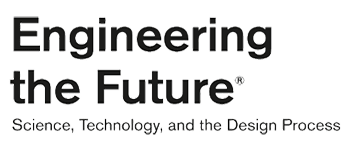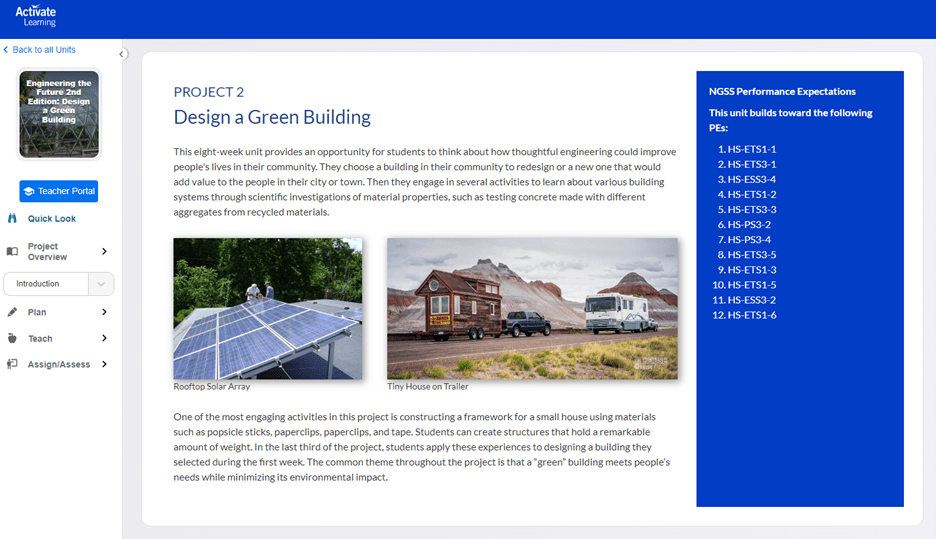
Students Learn Like Scientists and Engineers
Engineering the Future is a high school STEM curriculum that can be taught as a one-year course or as four eight-week projects.
This high school STEM course builds technological literacy and provides a strong foundation in physics and offers students an opportunity to explore the social, historical, and environmental contexts of emerging technologies.
Available as a package or for individual purchase
Digital
On the Activate Learning Digital Platform
Kits
Materials & Supplies
Professional Learning
Three-Dimensional
Project-Based Approach
Students explore crosscutting concepts of energy and matter, systems and systems models, and structure and function.
Students Learn Like Scientists and Engineers
Students invent and improve products, processes, and systems and discover the complementary relationships among science, mathematics, technology, and engineering.
Total Support
for Teachers
Professional Learning is provided by our team of education experts.
Need more info to decide if this the right curriculum for your district or school?
Engineering the Future Curriculum Details
Engineering the Future: Science, Technology, and the Design Process is a set of four design-based project modules, which can be taught as a one-year course or as four eight-week projects, that introduce students to the world of technology and engineering.
-
Real-World Connections
Through practical real-world connections, students have an opportunity to see how science, mathematics, and engineering are part of their everyday world, and why it is important for every citizen to be technologically and scientifically literate.
-
Maker Approach
Engineering the Future has a rich set of integrated STEM activities to appeal to a wide range of student interests and expands the use of a constructivist “maker” approach in which students design and build with both traditional engineering materials and new technologies, including 3D CAD and electronics.
-
NGSS Alignment
Engineering the Future, 2nd Edition, is designed to fully support Next Generation Science Standards (NGSS) and Standards for Technological Literacy (STL), as well as standards of many states.
Engineering the Future Modular Design
Engineering the Future should be considered as one step in a sequence of courses that students take as they progress through high school. When students complete this course, they will have a broader understanding of the wide variety of technical careers that are open to them.
Introduction to Engineering Course
Placement of this course in eighth or nineth grade opens students to career interests that would otherwise have lain dormant. The early hands-on maker approach to integrated engineering and science serves to inspire future interest in later sciences and engineering courses, opening a door for those who wish to enroll in technical studies at a college or university.
Physical Science Foundations
The course can be used as the foundation of a project-based course in physical science, integrated with engineering design. Given the large number of physical science standards that are the focus of these activities, some of our pilot teachers testing the second edition have received approval to consider EtF to be a fully accredited physical science ninth-grade course.
Capstone Engineering Course
Engineering the Future can serve as a capstone course for high school juniors or seniors to apply all that they learned in high school to practical situations, ranging from science and math to history, social studies, communication—even art and music. The course can also provide an excellent introduction to the fields of engineering for students who are considering technical careers.
Summer and After-School STEM Programs
Given the "maker" approach aspects of instruction, and high priority on activities that engage students’ creativity, these projects could also be useful in a STEM after-school or summer program.
Jump Into Engineering engages students with a creative design project—to invent a mobile device accessory—on the first day. Later students learn the more systematic engineering design process. As in the prior edition, students learn to make orthographic and isometric scale drawings to develop skills in translating observations into mental models, which is the essence of “looking and drawing.”
Building on successes from the “maker” movement, we expand on this in the second edition by adding 3D Computer-Aided Design (CAD). Students utilize CAD in a more authentic design process for the major project, to design an organizer to meet the needs of end-users based on a survey that the students plan and conduct. The students select materials, create a CAD model of their design, and conduct a life cycle analysis and peer review, among other tasks.
Digital Platform
The Activate Learning Digital Platform (ALDP) hosts the interactive digital edition of the Engineering the Future teacher and student curriculum materials.
The platform is designed for student accessibility and inclusion and offers embedded translation for over 130 languages and text-to-speech with read-along highlighting in 35 languages.
Featuring an intuitive user experience, teachers have everything they need to Plan, Teach, Assign, and Assess lessons in a platform that is integrated with leading SIS rostering and Learning Management Systems such as Google Classroom, Schoology, and Canvas.

About The Authors
Select an author to learn more about their contributions to the fields of engineering, physical science, astronomy, mathematics, and education.
Testimonials Kind Words from Administrators & Teachers.
Engineering the Future Videos
Engineering the Future

Student Experiences

Case Study

